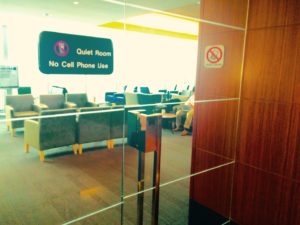SMOKING IN AIRPORTS IS A PUBLIC HEALTH HAZARD
Good news: Today most U.S. airports are 100% smokefree indoors for the health and safety of passengers and employees. But at a handful, passengers are still greeted by noxious secondhand smoke.
Breaking News: Atlanta Hartsfield-Jackson Airport will be smokefree by January 2020 as part of the Smokefree Atlanta law. Congratulations ATL!
As of July 2019, more than 600 U.S. airports are smokefree indoors, including most hub airports such as Denver, Salt Lake City, Chicago O’Hare, JFK, and SFO. See our lists of 100% Smokefree U.S. Airports and Smoking Policies in the 35 Busiest U.S. Airports.
Some airports, like Indianapolis, are also smokefree outdoors, which helps eliminate the gauntlet of toxic smoke surrounding building entrances and shuttle stops.
Airports big and small have repurposed former smoking areas into more useful spaces, such as seating areas, retail shops, and charging stations. Today, 87% of U.S. adults are nonsmokers. It is time that airports prioritize employee and traveler health over tobacco industry profits!
U.S. airports that still allow indoor smoking include Washington Dulles Airport (based in Philip Morris’ home state of Virginia), McCarran Las Vegas, Memphis, Nashville, Cincinnati-Northern KY; and Biloxi. Let these airports know you want 100% smokefree indoor air!
Just as the tobacco industry fought for years to keep smoking on airplanes, it has also fought relentlessly to keep smoking in airports via schemes such as the Philip Morris Airport Options program designed to undermine smokefree policies and maximizing smoking rates. Airport smoking rooms -present and past- were the direct result of tobacco industry front groups and lobbying.
Airport smoking rooms do not stop secondhand smoke from wafting throughout a building and do not address the health hazards of secondhand smoke. This is affirmed by ASHRAE, the standard setting body for ventilation. Even brief low levels of exposure can trigger heart attack, stroke or asthma attacks in at-risk travelers. Long term exposure increases risk of cancer and other chronic disease for airport workers.
Internationally, many airports are now 100% smokefree, including major Asia hubs such as Beijing, Shanghai, and Bangkok. See our partial list of international smokefree airports.
A study published in the November 22, 2017 issue of Morbidity and Mortality Weekly Report found that 23 of the world’s 50 busiest airports have smokefree indoor policies. The report affirms a growing trend toward smokefree airports worldwide.

